Veuve Clicquot
by
Terry Sullivan
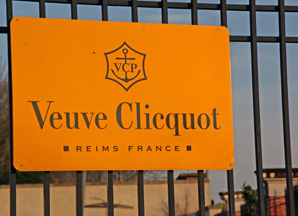 Summary: Veuve Clicquot, the second largest champagne house, owns over 400 hectares of vineyards. The champagne house has a strong connection to the past. We visited the house during an evening tour and reception.
Summary: Veuve Clicquot, the second largest champagne house, owns over 400 hectares of vineyards. The champagne house has a strong connection to the past. We visited the house during an evening tour and reception.
History
Philippe Clicquot founded the Veuve Clicquot champagne house in 1772. The family was in the banking and textile businesses. They owned a number of vineyards and decided to establish a wine business using the family name. The first shipment of wine was exported in 1798 to Venice. Philippe passed away and his wife Barbe Nicole Clicquot Ponsardin (Madame Clicquot) took over the business in 1805; she was 27 years old. She became one of the first business women of the modern era. In 1805, 110,000 bottles were shipped, many to Russia.
In the earlier years, still wines were crafted and shipped. By 1810, Madame Clicquot produced the first recorded vintage of champagne in the region. A year later, an exceptional vintage was made and set the course for the company’s future. Despite an embargo in Europe, Madame Clicquot shipped 10,550 bottles of wine to Russia in 1814. The champagne became quite popular and was praised by Pushkin, Chekhov and Gogol.
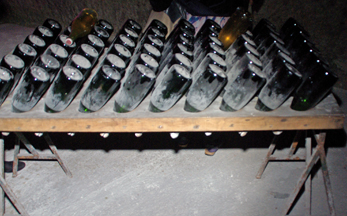 Madame Clicquot was a creative individual. In 1816 she is credited with creating the first riddling table, an invention that is still used in some sparkling wine production throughout the world. Madame Clicquot’s peers called her “La Grande Dame.”
Madame Clicquot was a creative individual. In 1816 she is credited with creating the first riddling table, an invention that is still used in some sparkling wine production throughout the world. Madame Clicquot’s peers called her “La Grande Dame.”
Veuve Clicquot continued through the decades. Madame Clicquot never remarried and the company was turned over to her business partner 1841. The company trademarked their yellow label in 1877. Yellow was an unusual color for a champagne label; however, there was a great deal of consumer awareness. In time, the yellow label became a distinguishing feature of House Veuve Cliquot. The company moved to Reims in 1909 and took advantage of crayeres, caves dug out during the Middle Ages. The crayeres became home to the visitor’s center and production area. As we ambled through the caves, we noticed names of individuals in larger cavern rooms. These are names of employees of Veuve Clicquot who have worked for the company for 40 years.
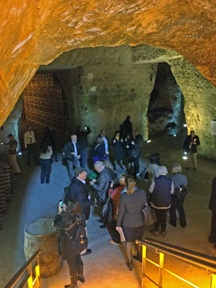
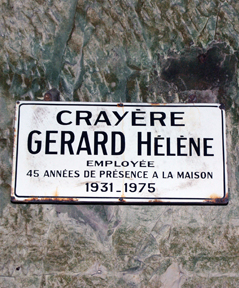
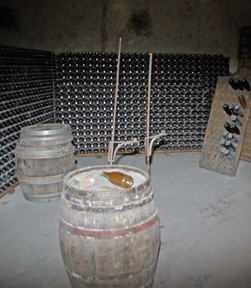
In 1972, the champagne house reached back to its history. To celebrate its bicentennial, Veuve Clicquot launched La Grande Dame, a prestigious vintage champagne. The company has always had a strong connection to its past. In 2010 a shipwreck was discovered off the coast of Finland’s Aland Islands. Salvaged from the ship were 47 champagne bottles of Veuve Clicquot. These became some of the oldest bottles of champagne in the world.
Symbols
From the very beginning of the champagne house, Philippe Clicquot chose the symbol of an anchor to represent the house. The anchor is a Christian symbol for hope and rigor, the traits that a new business hopes to enjoy. Veuve Clicquot has employed the use of other symbols through the generations. In 1811 a comet was observed over the Champagne area of France. Madame Clicquot used grapes from the “comet harvest” to craft an outstanding Vins de la Comète. The symbol of a comet reminds the champagne house of excellence.
Vineyards
The vineyards cover over 400 hectares (a little under 1,000 acres). Many of the vines are planted on hillsides and spread over Champagne. The house has vineyards in 12 of the Grand Crus and 18 of the Premier Crus. The house also sources grapes from growers. During harvest, the champagne house needs 1,200 people to harvest grapes. Grapes are pressed in the vineyards and sent to the winery for fermentation. The primary grape in the Veuve Clicquot portfolio is Pinot Noir. The house likes this grape for the structure it provides for champagnes.
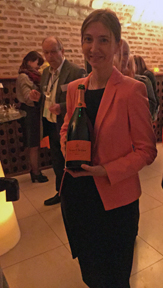 Champagnes
Champagnes
The house exceeds minimum requirements for aging champagnes. Typically non-vintage champagnes are aged for three years and vintage champagnes are aged for over five years. Some of the top of the line champagnes are aged for ten or more years. We met winemaker, Delphine Laborde (pictured) who likes the challenge of creating the best champagnes that they can each year.
The Brut Yellow Label NV was a blend of mostly Pinot Noir (between 50 and 55%), Chardonnay (between 28 and 33%) and Pinot Meunier at 15 percent. The wines did go through malolactic fermentation. The dosage was 9 g/l and the champagne was disgorged in 2014. The yellow color champagne had columns of beads forming a mousse. The aroma and taste reminded me of apples and peaches. There was a bright crispness and lemon on the finish.
Our wine tasting was at a reception for writers and wine tourism providers. The staff made sure that our glasses were always filled. There was also a constant stream of different finger foods that paired with the Yellow Label Brut. Entertainment included dance and magic, where a guest was levitated.
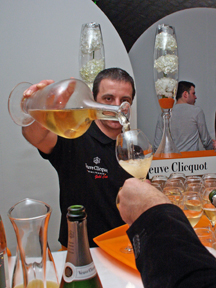 As the sweet finger foods arrived, we tasted the Demi-sec. The Veuve Clicquot Demi-Sec offered a bit of sweetness to its blend of Pinot Noir, Chardonnay and Pinot Meunier. The champagne was decanted and immediately poured into champagne glasses. This light-yellow color wine is the sweetest wine produced by the house. It had a few columns of beads and a small mousse. The wine offered apple and pear with some minerality.
As the sweet finger foods arrived, we tasted the Demi-sec. The Veuve Clicquot Demi-Sec offered a bit of sweetness to its blend of Pinot Noir, Chardonnay and Pinot Meunier. The champagne was decanted and immediately poured into champagne glasses. This light-yellow color wine is the sweetest wine produced by the house. It had a few columns of beads and a small mousse. The wine offered apple and pear with some minerality.
Wine Tourism
Veuve Clicquot offers an interesting tour of the caves in their Reims location. Learn about their history, La Grande Dame of Champagne and the house’s strong connection to history. The champagne house is open for tours and tasting from Tuesday through Saturday, 25 March
through 15 November. Appointments are made by phone. Call +33 (0) 3.26.89.53.90 for reservations.
Veuve Clicquot
Champagne Veuve Clicquot
1 Place des Droits de l'Homme - 51100 Reims
+33 (0)3 26 89 53 90
Article written April 2015
Visit these tour operators that partner with Wine Trail Traveler.
 |
||||
France
|
France
|
France | SmoothRed London, England, United Kingdom |


